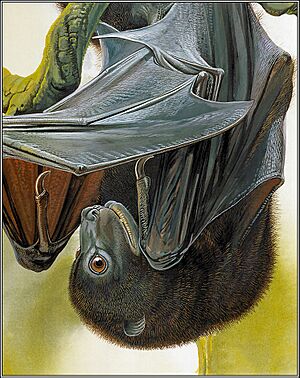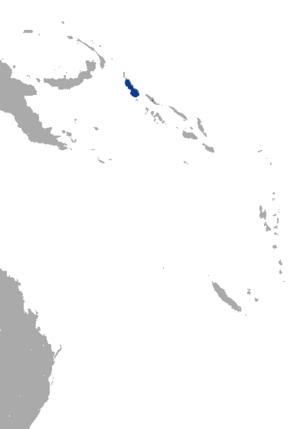Bougainville monkey-faced bat facts for kids
Quick facts for kids Bougainville monkey-faced bat |
|
|---|---|
 |
|
| Illustration by Peter Schouten | |
| Conservation status | |
| Scientific classification | |
| Genus: |
Pteralopex
|
| Species: |
anceps
|
 |
|
| Bougainville Monkey-faced Bat range | |
The Bougainville monkey-faced bat (Pteralopex anceps) is a special type of large bat. It lives only on Bougainville Island in Papua New Guinea and Choiseul Island in the Solomon Islands. These islands are part of a region called Melanesia. This bat prefers to live in old, grown-up forests high up in the mountains.
Discovering the Bat
This unique bat was first found by an English explorer named Albert Stewart Meek in April 1904. He found it on Bougainville Island. Later, a Danish scientist named Knud Andersen used that bat to officially describe it as a new species in 1909.
The bat's scientific name, anceps, comes from a Latin word meaning "double-headed." This might be because it was the second bat of its kind to be described. Or, it could be because it looked a bit like two different types of bats: Pteralopex and Pteropus. For a while, some scientists thought it was a subspecies (a type of variation) of another bat, the Guadalcanal monkey-faced bat. But by 1978, it was recognized as its own separate species again.
What Does It Look Like?
This bat is the biggest in its group, called Pteralopex. Its forearms, which are like its "arms," can be about 14 to 16 centimeters (5.5 to 6.3 inches) long. You can spot this bat by its short ears, which are mostly hidden by its fur.
Its head and back are covered in black fur. But its chest has a patch of white or yellow fur. The fur is long, with individual hairs about 2 centimeters (0.8 inches) long. Unlike some other bats, its lower leg (called the tibia) is completely covered in fur.
The Bougainville monkey-faced bat has a very strong skull. It has thick cheekbones (called zygomatic arches) and a high bony ridge on top of its head (called a sagittal crest). These features suggest it has a powerful bite. Its teeth are arranged in a specific way, which scientists call a dental formula. Like other bats in its group, its eyes are thought to be red or orange. It does not have a tail. Male and female bats are about the same size.
Bat Behavior
Scientists have seen these bats resting in fig trees. They can be found roosting (resting) alone or in groups. We don't know exactly what they eat. However, bats studied in museums have teeth that are very worn down. This suggests they might eat hard, tough fruits.
Where It Lives
Most of the bats studied by scientists were found in cloud forests. These forests are high up, usually 1,100 meters (about 3,600 feet) or more above sea level. This bat probably doesn't live in forests near the coast.
The Bougainville monkey-faced bat was not seen on Bougainville Island for a long time, from 1968 until 2016. It was last seen on Choiseul Island in 2008.
Protecting the Bat
In 1992, people worried that this bat might be extinct because it hadn't been seen. But in 1995, a group of researchers found six of them over six months. Because its numbers were thought to be dropping fast, some people suggested trying to breed these bats in zoos. However, as of 2017, there isn't a program like that.
This bat is listed as an Endangered species on the IUCN Red List. This means it is at a high risk of becoming extinct. The main dangers to this bat are when its forest home is destroyed for farming. It is also hunted for bushmeat, which means it is eaten by people. In 2013, a group called Bat Conservation International put this bat on its list of 35 top priority species to protect worldwide.
Bat Conservation International is working hard to save this species. They are partnering with the local Rotokas people, a group called Volunteer Service Abroad, and the Bougainville Bureau for the Environment. Together, they are creating a plan to protect an important area called Kunua Plains & Mount Balbi Key Biodiversity Area. This plan aims to help both the Bougainville monkey-faced bat and the greater monkey-faced bat.
Some of the ways they are trying to help include:
- Finding other food sources for local people so they don't need to hunt bats.
- Starting tree nurseries to plant new native trees and help the forests grow back.
- Helping farmers and fruit-eating bats get along better, so farmers don't harm the bats to protect their crops.
- Talking more often with the community about how to protect nature.
Researchers who want to work in the Kunua Plains & Mount Balbi area will pay the Rotokas people to use their land. They will also hire local guides and helpers from nearby villages. And they will buy food from local farmers. This helps the Rotokas people earn money while also protecting the bats.


